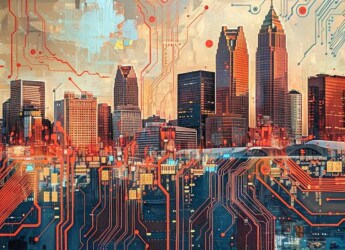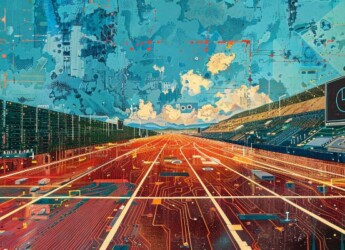Editor’s Note: The rapid convergence of Graphics Processing Units (GPUs), Artificial Intelligence (AI), and Quantum Computing is ushering in a transformative era of technological innovation with profound implications for cybersecurity, information governance, and eDiscovery. This article delves into the emerging synergies among these cutting-edge technologies, highlighting their potential to revolutionize industries and enhance computational efficiency and security. As GPUs evolve beyond their traditional roles, their integration with quantum technologies and AI is paving the way for revolutionary applications in sectors ranging from finance and healthcare to cybersecurity and legal eDiscovery. This confluence is not only accelerating problem-solving capabilities but also redefining the landscape of digital security and compliance, promising a future where the most intricate challenges across industries can be addressed with unprecedented precision and speed.
Content Assessment: The Convergence of GPUs, Quantum Computing, and AI - Ushering in a New Era of Technological Innovation
Information - 90%
Insight - 88%
Relevance - 89%
Objectivity - 90%
Authority - 88%
89%
Good
A short percentage-based assessment of the qualitative benefit expressed as a percentage of positive reception of the recent article from ComplexDiscovery OÜ titled, "The Convergence of GPUs, Quantum Computing, and AI: Ushering in a New Era of Technological Innovation."
Industry News – Artificial Intelligence Beat
The Convergence of GPUs, Quantum Computing, and AI: Ushering in a New Era of Technological Innovation
ComplexDiscovery Staff
The convergence of Graphics Processing Units (GPUs), Artificial Intelligence (AI), and Quantum Computing is propelling us into a new era of advanced technological capabilities that promise to transform a myriad of industries. As these technologies continue to evolve, they pave the way for unprecedented advancements in computing power and efficiency, offering solutions to some of the most daunting challenges faced by humanity today.
GPUs have long been recognized for their superior ability to handle complex graphics and video processing tasks. However, their parallel processing capabilities, which enable faster execution of complex computations essential in machine learning, have made them increasingly valuable in AI applications. As a result, GPUs have become pivotal in enhancing the efficiency and capabilities of AI-driven applications across various sectors, from healthcare and finance to transportation and manufacturing.
Simultaneously, the field of quantum computing is achieving new milestones. Quantum Computers, like the IBM-developed Heron, which features hundreds or thousands of qubits, are demonstrating the potential to perform calculations at speeds significantly faster than traditional computers. This jump in computing power is largely due to the fundamental properties of qubits, which can exist in multiple states simultaneously, unlike binary bits that operate on a single state at any given time. As quantum computing continues to advance, with companies like Google, IBM, and Microsoft investing heavily in the technology, we are likely to see even more powerful quantum computers in the near future.
The integration of Quantum Computing with AI, known as Quantum AI, is poised to revolutionize industries such as finance, healthcare, cybersecurity, and eDiscovery. In financial markets, predictive analysis can be transformed by Quantum AI’s ability to handle vast data sets and perform complex calculations at high speeds, offering more accurate forecasts and optimized trading strategies. In the healthcare domain, Quantum AI could facilitate rapid genomic data analysis to accelerate drug discovery processes and personalize medical treatments, potentially saving countless lives and reducing healthcare costs.
In the realm of cybersecurity, Quantum AI could play a crucial role in enhancing the security of digital systems. With its ability to analyze vast amounts of data and identify patterns, Quantum AI could help detect and prevent cyber threats in real-time. Furthermore, quantum computing’s potential to break traditional encryption methods has led to the development of quantum-resistant cryptography, which could provide a higher level of security for sensitive data.
eDiscovery, the process of identifying, collecting, and producing electronically stored information in legal proceedings, could also benefit from the advancements in Quantum AI. The technology could enable faster and more accurate analysis of large volumes of digital data, reducing the time and cost associated with the eDiscovery process. Additionally, Quantum AI could assist in identifying relevant documents and detecting potential evidence tampering, ensuring the integrity of the legal process.
These advancements are not without challenges. The integration of GPUs with quantum computers involves navigating compatibility issues due to the fundamentally different mechanisms by which these technologies operate. Additionally, there are significant challenges related to scaling quantum computing capabilities to more practical levels using quantum error correction techniques to manage the sensitivity of qubits to errors and ensure reliable operations. Despite these obstacles, researchers and industry leaders are making steady progress in overcoming these hurdles.
The trajectory of these technologies, backed by organizations such as Microsoft through their Azure Quantum platform, points towards an exciting future where fault-tolerant quantum computing could become a reality. This would not only enhance the performance of quantum AI applications but also expand their practical usability across industries. Furthermore, the development of hybrid quantum-classical algorithms, which leverage the strengths of both classical and quantum computing, is opening up new possibilities for solving complex problems that were previously intractable.
Moreover, as the integration of AI with open-source frameworks and collaboration across industries continues to increase, we are likely to witness more inclusive and accessible technological advancements. Platforms like GitHub provide a vibrant community for developers to collaborate, contributing to the democratization of technology and innovation. This collaborative approach is crucial in driving the development and adoption of these cutting-edge technologies.
The anticipation surrounding these technologies suggests a future where complex problems across industries, including cybersecurity and eDiscovery, could be tackled more effectively than ever before, heralding a new era of scientific discovery and technological innovation. As GPUs, AI, and Quantum Computing continue to converge and evolve, we can expect to see groundbreaking advancements in fields such as material science, climate modeling, and cryptography, among others.
The convergence of GPUs, AI, and Quantum Computing represents a significant milestone in the history of technological advancement. As these technologies continue to mature and integrate, they promise to reshape our world in ways we can only begin to imagine, addressing challenges in diverse fields such as cybersecurity and eDiscovery. It is an exciting time for researchers, industry leaders, and society as a whole, as we stand on the precipice of a new era of innovation and discovery.
News Sources
- How GPUs, AI, and Quantum Computers Can Work Together
- Quantum Computing and Generative AI: The Next Frontier
- Microsoft’s Leap Towards Fault-Tolerant Quantum Computing with Azure Quantum
- Bridging GPU Owners with the Open Source AI Community: Heurist AI
Lagniappe
What does a quantum computer look like?
Quantum computers differ significantly in appearance from traditional classical computers. While your standard desktop or laptop is quite familiar, quantum computers are much more unique and complex. Here’s what a typical quantum computer looks like:
1. Cooling Systems: Quantum computers operate at incredibly low temperatures, often close to absolute zero (-273.15°C or -459.67°F). They are typically housed in dilution refrigerators, which are large cylindrical structures that use a mixture of helium isotopes to achieve these low temperatures. These refrigerators can be visually striking, often resembling large metallic cylinders or tubes, sometimes with a gold-plated interior.
2. Wiring and Superconducting Circuits: Inside the refrigerator, quantum processors are small chips that may be no larger than a coin. They are connected to the outside world through a series of superconducting cables and wiring, which are essential for carrying control signals to the qubits and reading out their states without introducing noise.
3. Control Electronics: Outside of the cooling systems, you’ll often see racks of electronics that manage the quantum computer’s operations. These include the systems that generate microwave pulses or laser beams, depending on the type of qubit technology used. These pulses are used to perform quantum operations on the qubits.
4. Data Infrastructure: Much like traditional computers, quantum computers are supported by a significant amount of data infrastructure, including classical computing resources and storage systems. These are used for tasks like setting up the quantum algorithms, processing the outputs from the quantum computer, and managing the overall system.
5. Sophisticated Design: The overall design and architecture of quantum computers are highly specialized and advanced, involving cutting-edge physics, engineering, and materials science. The aesthetics can be quite futuristic, with an array of optical components, vacuum chambers, and intricate wiring, all of which are meticulously organized to support quantum operations.
Overall, a quantum computer looks more like an experimental physics lab setup than the typical computers most people are familiar with. It’s a complex assembly of high-tech components designed to control and read out qubits with high precision, all within an environment that minimizes external disturbances.
Assisted by GAI and LLM Technologies
Additional Reading
- U.S. Proposes New AI Export Controls Amid Security Concerns
- From Silicon Valley to Sacramento: California’s Bold AI Regulatory Framework
Source: ComplexDiscovery OÜ























